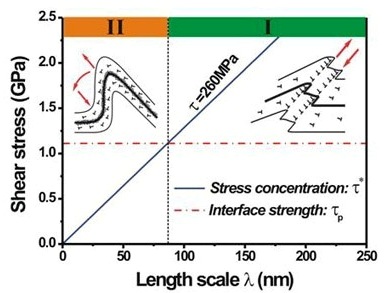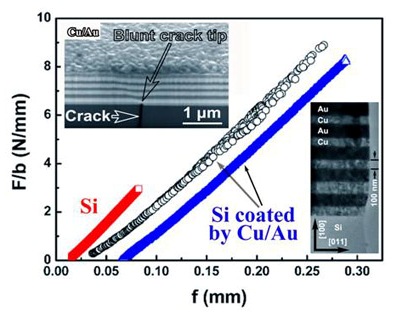Strength and toughness are the two most important factors of mechanical properties for structural materials, and are subject to more demands due to increasingly severe service conditions and environments. The basic idea of traditional strategies to strengthen metallic materials is to inhibit dislocation motion through decreasing microstructural length scales, e.g. spacing between second phase particles, grain size etc. It has been verified empirically that monotonically changing modulation microstructural length scales often leads to an imbalance between strength and toughness of materials, i.e. high strength is achieved at the cost of the lowered toughness. How to make an effective tradeoff between strength and toughness, or find ways to increase material strength while maintain toughness has currently become one of crucial problems for the strengthening-toughening design of metallic structural materials.
Layered metallic materials are composites stacked alternatively by two or more metallic components with controllable length scale and interfaces. When the individual layer thickness of components decreases to nanometer scale, the strength of such layered materials can reach the theoretical strength by a factor of 1/3, which is 2 to 3 times the strength predicted by the rule of mixture. The component length scale (dimensional and microstructural) of layered metallic materials can be modulated; furthermore components with different intrinsic properties and heterogeneous interlayer interfaces with different structures can also be incorporated. Thus, it is expected that layered metallic materials may have a potential to become metallic structural materials with high strength and good ductility.
Recently, Prof. Guangping Zhang and his group, at the Shenyang National Laboratory for Materials Science,Division of Fatigue and Fracture of Materials, Institute of Metal Research, Chinese Academy of Sciences, have designed two Cu-based layered materials with different components and interface structures (f.c.c. Cu/f.c.c. Au, individual layer thickness ratio Cu:Au = 1:1; f.c.c. Cu/b.c.c. Cr, individual layer thickness ratio Cu:Cr = 2:1), while individual layer thickness ranges from sub-micron to a few nano-meters. They have systematically studied the strengthening mechanisms, plastic deformation stability, size and interface effects on mechanical properties of metallic composites subjected to nanoindentation. They have also explored the possibility of these layered composites to be coated on surface of brittle materials to improve the toughness of the latter. They found that the strength of both composites increases as individual layer thickness decreases, i.e. following a Hall-Perth relation, when individual layer thickness is larger than 50 nm. However, the interface strengthening ability is different. After a detailed analysis of the interface strengthening ability and interface structure of several Cu-based layered materials (Cu/X,X:Au、Ni、Ag、Nb、Al、304 Stainless Steel), they found that interface strengthening ability depends on interface structure, which determines interface mismatch. The interface strengthening ability increases as interface mismatch strain increases. Then the researchers developed a unified model to evaluate the interface strengthening ability for layered metallic materials, which is able to describe the interface strengthening effects of layered materials with different heterogeneous interfaces and interfaces mismatch, thus reach a balance between microstructural length scales and interface structures, compared with the monotonic modulation of microstructural length scales.
Based on the observation on the indentation induced deformation behavior, it was found that Cu/Au layered material tends to form shear bands in the vicinity of indentation which lead to unstable deformation when the individual layer thickness is at the nanometer scale, compare to direct cross-interface shear deformation of the layered material at the submicron scale. On the other hand, the Cu/Cr layered material has better plastic deformation stability. The researchers have developed a model based on dislocation - interface interaction and competition, and predict the transition of deformation behavior mentioned above (Figure 1). When the individual layer thickness of Cu/Au multilayers is at the submicron scales (> 80 nm), the stress concentration due to dislocation pile up at the interface is larger than interface barrier strength, thus leads to cross interface shear deformation. When the individual layer thickness of Cu/Au multilayers is at the nanometer scales (< 80 nm), the capacity to store dislocation in a layer is decreased, the stress concentration at the interface due to dislocation pile up is also decreased, thus the interface mobility is increased, then interface-accommodated localized shear banding that leads to unstable deformation is more favorable. Further analysis of interface structure reveals that, compared with opaque interface in the Cu/Cr with a large modulus mismatch, transparent interface in the Cu/Au with a low modulus mismatch has a good slip continuity, thus leads to the different resistance to unstable plastic deformation for two composites. Based on above analysis, the researchers studied the effects of Cu/Au multilayers on fracture properties of brittle materials when they were coated by the Cu/Au multilayers. It was found that the bending fracture load of Si single crystals coated with 1-micron thick Cu/Au multilayers is much larger than that of Si single crystals without the coatings (Figure 2). Cu/Au layered coating can significantly improve the toughness of the brittle material by effectively delaying the unstable propagation of cracks in the brittle material through plastic deformation in itself and interface-mediated ability.
Above results have been published in Appl. Phy. Lett. 92 (2008) 161905, Scripta Mater. 59 (2008) 1226,J. Mater. Res. 24 (2009) 728,Philo. Mag. Lett. 89 (2009) 66,Adv. Eng. Mater. 11 (2009) 63. A further study on the strengthening-toughening mechanisms of layered metallic materials, the fracture behavior, size effects and interface effects at the atomic scale is still undergoing. This work was supported by the National Natural Science Foundation of China and the National Basic Research Program of China.

Figure 1 Two types of mechanisms of indentation-induced unstable plastic deformation of Cu/Au layered materials with different individual layer thicknesses, Region I: dislocation-slip-induced shear deformation, Region II: interface-accommodated shear deformation

Figure 2 Enhancement of bending fracture properties of a Si single crystal coated with 1 mm-thick Cu/Au multilayer with individual layer thickness of 100 nm, and retardation of crack growth of the brittle substrate shown in the left inset.